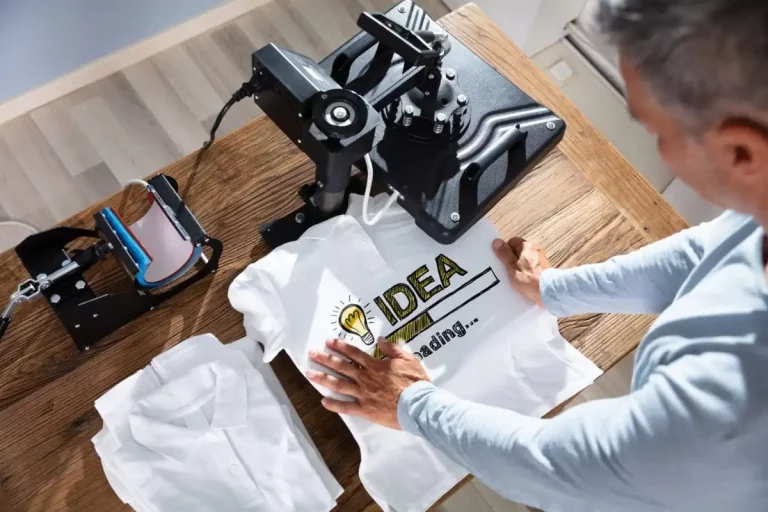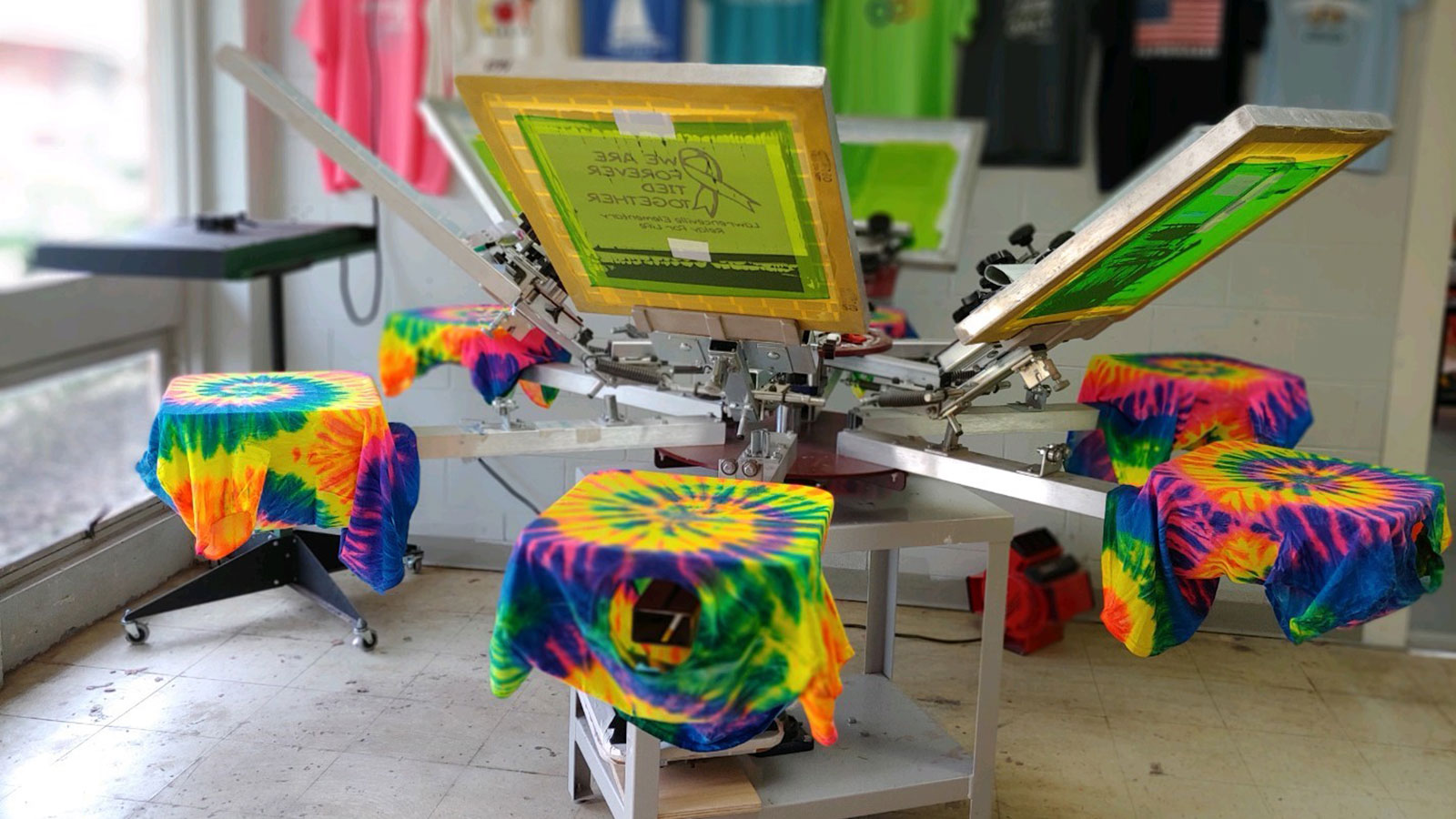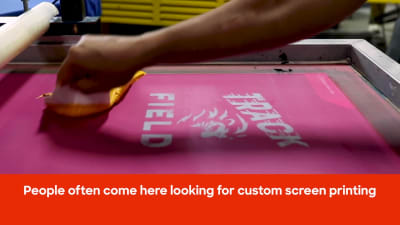Affordable Custom Screen Printing Services for Small Businesses
Affordable Custom Screen Printing Services for Small Businesses
Blog Article
Screen Printing Uncovered: Every Little Thing You Need to Learn About T-Shirt and Garment Printing Strategies
Screen printing is a remarkable approach that combines art with technique, providing limitless opportunities for creativity. Prepared to explore the necessary components that make display publishing an art type?
The Basics of Display Printing: Just How It Works
When you plunge into display printing, you'll discover it's both an art and a science. At its core, screen printing entails creating a stencil, or display, that permits ink to pass via just in details locations.
Following, you'll mix your inks and prepare your printing surface. Placement the display over the textile, after that utilize a squeegee to push ink through the screen onto the garment. This process requires precision, as you desire clear, dynamic prints. After printing, you'll cure the ink with heat, ensuring it complies with the material and lasts with cleans. Each action is necessary, and mastering them will certainly raise your display printing abilities, changing basic garments right into distinct, expressive items.
Kinds Of Display Printing Strategies
As soon as you realize the basics of screen printing, it's time to discover the different methods that can elevate your styles. One prominent approach is traditional display printing, where ink is pushed through a stenciled screen.
If you're going for great details, take into consideration discharge printing. This technique eliminates dye from the material, leaving a soft, classic appearance. An additional choice is plastisol printing, known for its durability and vivid colors, making it a favorite for numerous brand names. Experiment with halftone printing to create slope results and elaborate layouts. Each method has its one-of-a-kind beauty, so do not hesitate to try them bent on locate what fits your style best!
Necessary Equipment for Screen Printing
To achieve spectacular results in screen printing, having the right equipment is essential. You'll need a durable screen printing frame, which holds the mesh that transfers your design onto the garment. Next off, invest in top quality squeegees; these are essential for using ink uniformly across the display. You'll additionally need a good direct exposure unit to create your screens, in addition to a washout booth for cleansing them after use. A trusted warm resource, like a conveyor clothes dryer or warmth press, is important for curing your prints to assure durability. Don't neglect an appropriate work space, equipped with tables and storage space for your supplies. Protective gear, such as handwear covers and masks, will certainly keep you risk-free from chemicals and inks. With the right devices, you'll be well on your method to producing professional-quality prints.
Choosing the Right Inks and Products
When selecting inks and materials for display printing, you require to take into consideration the kind of ink that works best for your task. Believe concerning material compatibility to assure your styles look last and great lengthy. Explore eco-friendly ink options to make your printing procedure more sustainable.
Kinds of Display Inks
Picking the best display ink is necessary for achieving vivid, durable prints that meet your project's requirements. There are numerous types of screen inks to examine. Specialized inks, such as metallic or glow-in-the-dark, can add distinct effects to your styles.

Fabric Compatibility Factors To Consider
Comprehending textile compatibility is important for accomplishing top quality screen prints, specifically considering that different materials react uniquely to various inks. When selecting inks, think about the textile kind-- cotton, polyester, or blends. For cotton, water-based inks function well, providing soft qualities and breathability. Polyester, on the various other hand, commonly needs plastisol inks for better attachment and dynamic shades. You might require to utilize a mix of both types if you're printing on blends. Always check your inks on example fabric to ensure they adhere correctly and preserve color honesty. Additionally, remember that fabric weight and texture can influence the final end result, so picking the best ink and material combination is crucial for your project's success.
Eco-Friendly Ink Options
Environmentally friendly inks are coming to be a preferred option for screen printers who desire to lessen their environmental impact while keeping high quality. When selecting inks, consider water-based inks, which are less harmful and much easier to cleanse up compared to standard solvents.
Furthermore, look for inks made from renewable energies, such as soy or vegetable-based alternatives. By choosing the best inks and products, you'll not just create sensational designs but likewise add to an extra lasting printing procedure. Make the switch, and your prints will certainly show your dedication to the setting!
Preparing Your Style for Display Printing

Submit Style Needs
To assure your design looks lively and sharp on material, you'll need to pay close focus to file style demands for display printing. Make certain your layout has a transparent background to avoid undesirable white sides on your prints. Maintain color modes in mind; CMYK is standard for display printing, so convert your RGB makes accordingly.
Shade Splitting Up Techniques
Shade splitting up is a crucial step in preparing your design for display printing, and grasping it can considerably improve your print quality. You'll require to break your style right into specific shades, as each color needs a separate display during printing. This precision not just guarantees accurate shade representation yet likewise enhances the printing process.
Resolution and Dimension
Accomplishing the most effective cause display printing begins with guaranteeing your design has the best resolution and size. Ideally, your artwork needs to be at least 300 DPI (dots per inch) for sharp, clear prints. Your last item might look pixelated and amateur. if you make use of reduced resolution.
When it comes to dimension, think about the dimensions of your print location. Style your artwork to match the last print size, ideally creating it in the actual dimensions you'll be printing. In this manner, you'll stay clear of any type of unexpected scaling problems.
Constantly inspect your design in both vector and raster formats. Vector graphics can be scaled without shedding top quality, making them suitable for display printing. Preparing correctly will guarantee your style looks outstanding on every garment!
Step-by-Step Display Printing Process
Display printing is a vibrant procedure that allows you to develop lively layouts on numerous surfaces. To begin, you'll need a display, solution, and your picked ink. Initially, prepare your display by cleaning it thoroughly. Next off, use the solution uniformly and let it completely dry in a dark location. As soon as dry, reveal your screen to light with your design positioned on it, which will solidify the emulsion where the light hits, producing a pattern - screen printing kit.
After washing out the unexposed emulsion, your display is prepared. Establish it up on your printing surface area and align your garment below it. Pour ink onto the screen and utilize a squeegee to push the ink via the stencil onto the fabric. Lift the screen carefully and let the print dry. Treat the ink making use of warm to guarantee durability. That's it! find here You've efficiently screen printed your design.
Tips for Successful Display Printing Projects
While you're diving into your screen printing projects, bear in mind that prep work is key to success. Beginning by collecting all your materials-- inks, screens, squeegees, and garments. A tidy workspace assists protect against unwanted errors, so clean up before you begin.
Next, verify your art work is high-resolution and properly sized for your garment. Examine your screen for proper exposure and tidy it thoroughly to stay clear of smudges. When blending your inks, adhere to the maker's standards to attain the right consistency.
During printing, use also stress with your squeegee for consistent results. Don't hurry; take your time to validate each print meets your criteria. After printing, let your garments dry totally prior to handling or packaging them.
Lastly, always maintain a sample of your benefit future reference. In this manner, you address can evaluate your progression and improve your methods with time. Delighted printing!

Often Asked Questions
For how long Does It Take to Establish a Screen Printing Job?
Establishing up a display printing work usually takes around thirty minutes to an hour. You'll prepare the displays, mix inks, and adjust the press. The time varies based upon intricacy and experience, so stay arranged!
Can I Publish on Various Material Types Utilizing the Same Technique?
Yes, you can print on various textile kinds making use of the exact same technique, but you'll need to change your inks and setups. Some fabrics take in ink differently, so trying out warranties the most effective outcomes for each and every product.
What Are Common Errors to Stay Clear Of in Screen Printing?
When screen printing, prevent usual mistakes like utilizing the incorrect ink, neglecting proper exposure times, or skipping pre-press checks. Constantly test your setup and preserve tidy displays to ensure high quality results each time.
Just How Can I Appropriately Clean and Maintain My Screen Printing Tools?
To properly tidy and maintain your display printing tools, you need to consistently clean screens with suitable solvents, check squeegees for wear, and assure all devices are kept completely dry and dust-free. Uniformity protects against expensive fixings and enhances performance.
Is Display Printing Eco-friendly Contrasted to Various Other Techniques?
Screen printing can be a lot more eco-friendly than other approaches, specifically if you utilize eco-conscious products and water-based inks. By picking lasting supplies and methods, you reduce waste and reduce your effect on the world.
Screen Printing Uncovered: Everything You Required to Know About Tee and Garment Printing Strategies
At its core, display printing includes developing a stencil, or screen, that allows ink to pass with just in details areas. Position the screen over the textile, after that utilize a squeegee to press ink with the screen onto the garment. One preferred approach is typical display printing, where ink is pressed with a stenciled screen.When choosing inks and products for display printing, you need to take right into account the type of ink that works finest for your task.
Report this page